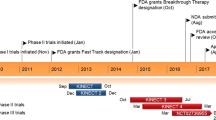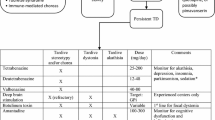Abstract
Valbenazine (Ingrezza®) is an orally bioavailable, selective and reversible vesicular monoamine transporter 2 (VMAT2) inhibitor that is indicated for the once-daily treatment of adults with tardive dyskinesia (TD) in the USA. By inhibiting VMAT2, thereby interfering with the presynaptic uptake and storage of dopamine and other monoamines, valbenazine is thought to counteract the heightened postsynaptic dopaminergic activity that is believed to cause TD. In adults with dopamine-receptor blocking agent-induced TD and underlying schizophrenia, schizoaffective disorder or mood disorder, valbenazine was associated with rapid, significant and sustained on-treatment improvements in TD severity relative to placebo. Somnolence is the most common treatment-emergent adverse event associated with valbenazine and, importantly, depression and extrapyramidal symptoms have not been associated with its use.
Similar content being viewed by others
References
Waln O, Jankovic J. An update on tardive dyskinesia: from phenomenology to treatment. Tremor Other Hyperkinet Mov (N Y). 2013;3:tre-03-161-4138-1.
Jones BD. Long-term neuroleptic toxicity and mood: blurring of diagnostic boundaries. In: Williams R, Dalby JT, editors. Depression in schizophrenics. Boston: Springer; 1989. p. 203–13.
Cloud LJ, Zutshi D, Factor SA. Tardive dyskinesia: therapeutic options for an increasingly common disorder. Neurotherapeutics. 2014;11(1):166–76.
Goel S, Ondo W. Tardive dyskinesia. In: Falup-Pecurariu C, Ferreira J, Martinez-Martin P, Chaudhuri KR, editors. Movement disorders curricula. Vienna: Springer; 2017. p. 283–9.
Aia PG, Revuelta GJ, Cloud LJ, et al. Tardive dyskinesia. Curr Treat Options Neurol. 2011;13(3):231–41.
Naber D, Lambert M. The CATIE and CUtLASS studies in schizophrenia: results and implications for clinicians. CNS Drugs. 2009;23(8):649–59.
Bhidayasiri R, Fahn S, Weiner WJ, et al. Evidence-based guideline: treatment of tardive syndromes: report of the Guideline Development Subcommittee of the American Academy of Neurology. Neurology. 2013;81(5):463–9.
Kim ES. Valbenazine: first global approval. Drugs. 2017;77(10):1123–9.
Ingrezza® (valbenazine) capsules, for oral use: US prescribing information. San Diego: Neurocrine Biosciences, Inc.; 2017.
Grigoriadis DE, Smith E, Hoare SRJ, et al. Pharmacologic characterization of valbenazine (NBI-98854) and its metabolites. J Pharmacol Exp Ther. 2017;361(3):454–61.
Ingrezza (valbenazine) capsules: medical review(s) [reference ID: 4079314]. Silver Spring (MD): US FDA Center for Drug Evaluation and Research; 2017.
Neurocrine Biosciences. Neurocrine announces phase IIb results of VMAT2 inhibitor NBI-98854 for treatment of tardive dyskinesia [media release]. http://www.neurocrine.com/. Accessed 9 Sep 2013.
O’Brien CF, Jimenez R, Hauser RA, et al. NBI-98854, a selective monoamine transport inhibitor for the treatment of tardive dyskinesia: a randomized, double-blind, placebo-controlled study. Mov Disord. 2015;30(12):1681–7.
Hauser RA, Factor SA, Marder SR, et al. KINECT 3: a phase 3 randomized, double-blind, placebo-controlled trial of valbenazine for tardive dyskinesia. Am J Psychiatry. 2017;174(5):476–84.
Ingrezza (valbenazine) capsules: summary review (reference ID: 4082860). Silver Spring (MD): US FDA Center for Drug Evaluation and Research; 2017.
Factor SA, Remington G, Comella C, et al. The effects of valbenazine in participants with tardive dyskinesia: results of the 1-year KINECT 3 extension study. J Clin Psychiatry. 2017;78(9):1344–50
Kane JM, Correll CU, Liang GS, et al. Efficacy of valbenazine (NBI-98854) in treating subjects with tardive dyskinesia and schizophrenia or schizoaffective disorder. Psychopharmacol Bull. 2017;47(3):69–76.
Correll CU, Josiassen RC, Liang GS, et al. Efficacy of valbenazine (NBI-98854) in treating subjects with tardive dyskinesia and mood disorder. Psychopharmacol Bull. 2017;47(3):53–60.
Thai-Cuarto D, O’Brien CF, Jimenez R, et al. Cardiovascular profile of valbenazine: analysis of pooled data from three randomized, double-blind, placebo-controlled trials. Drug Saf. 2017. https://doi.org/10.1007/s40264-017-0623-1 [Epub ahead of print].
Remington G, Factor S, Comella C, et al. Safety and tolerability of valbenazine (NBI-98854) in subjects with tardive dyskinesia: results of long-term exposure data from three studies [abstract no. P2.017]. Neurology. 2017;88(16 Suppl).
Josiassen RC, Kane JM, Liang GS, et al. Long-term safety and tolerability of valbenazine (NBI-98854) in subjects with tardive dyskinesia and a diagnosis of schizophrenia or mood disorder. Psychopharmacol Bull. 2017;47(3):61–8.
Austedo® (deutetrabenazine) tablets: US prescribing information. North Wales (PA): Teva Pharmaceuticals USA, Inc.; 2017.
Josiassen RCJ, Filmyer DM, Gillean J, et al. Successful treatment of severe tardive dyskinesia with valbenazine, including a patient’s perspective. Am J Case Rep. 2017; 18:1185–9. https://www.amjcaserep.com/download/index/idArt/906454
Acknowledgements
The manuscript was updated from Drugs 2017;77(10):1123–29 [8], and was reviewed by: L.J. Cloud, Department of Neurology, School of Medicine, Virginia Commonwealth University, Richmond (VA), USA; J.H. Friedman, Movement Disorders Program, Butler Hospital, and Department of Neurology, Warren Alpert Medical School of Brown University, Providence (RI), USA; R.C. Josiassen, Translational Neuroscience LCC, Conshohocken (PA),USA; M. Solmi, Psychiatry Unit, Neurosciences Department, University of Padua, Padua, Italy. During the peer review process, the manufacturer of valbenazine was also offered an opportunity to review this article. Changes resulting from comments received were made on the basis of scientific and editorial merit.
Funding
The preparation of this review was not supported by any external funding.
Author information
Authors and Affiliations
Corresponding author
Ethics declarations
Conflicts of interest
E.S. Kim and K.A. Lyseng-Williamson are employees of Adis/Springer, are responsible for the article content and declare no conflicts of interest.
Additional information about this Adis Drug Review can be found here http://www.medengine.com/Redeem/C9ECF060386A50C9.
Rights and permissions
About this article
Cite this article
Kim, E.S., Lyseng-Williamson, K.A. Valbenazine in tardive dyskinesia: a profile of its use. Drugs Ther Perspect 34, 99–104 (2018). https://doi.org/10.1007/s40267-018-0479-1
Published:
Issue Date:
DOI: https://doi.org/10.1007/s40267-018-0479-1




